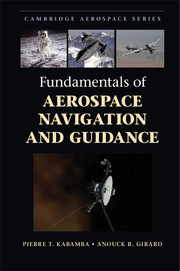Book contents
- Frontmatter
- Dedication
- Contents
- Preface
- 1 Introduction
- 2 Deterministic Systems Theory
- 3 Stochastic Systems Theory
- 4 Navigation
- 5 Homing Guidance
- 6 Ballistic Guidance
- 7 Midcourse Guidance
- 8 Optimization
- 9 Optimal Guidance
- 10 Introduction to Differential Games
- Epilogue
- APPENDIX A Useful Definitions and Mathematical Results
- Bibliography
- Index
2 - Deterministic Systems Theory
Published online by Cambridge University Press: 05 October 2014
- Frontmatter
- Dedication
- Contents
- Preface
- 1 Introduction
- 2 Deterministic Systems Theory
- 3 Stochastic Systems Theory
- 4 Navigation
- 5 Homing Guidance
- 6 Ballistic Guidance
- 7 Midcourse Guidance
- 8 Optimization
- 9 Optimal Guidance
- 10 Introduction to Differential Games
- Epilogue
- APPENDIX A Useful Definitions and Mathematical Results
- Bibliography
- Index
Summary
This chapter presents the fundamentals of deterministic systems theory that we use in the analysis and synthesis of aerospace navigation and guidance systems. The emphasis is on linear, time varying dynamic systems. This emphasis is justified in Section 2.1, where it is shown that when the trajectory of a nonlinear system undergoes a small perturbation, the time history of that perturbation can be approximated using a linear system. Thus, this linear approach is appropriate when the navigation and guidance errors are small. This, of course, implicitly assumes that we use successful navigation and guidance laws to ensure small errors.
In addition to system linearization, Section 2.1 surveys properties of linear dynamic systems: the state transition matrix and its features, various notions of stability and their criteria, the variation of constants formula, and the impulse response. Section 2.2 studies observability, which is a central concept in navigation. Section 2.3 considers the particular case of linear, time invariant dynamic systems. Section 2.4 presents the method of adjoints, which is invaluable in terminal guidance because it yields the miss distance due to a perturbation of the trajectory as a function of the time at which the perturbation is applied. Finally, Section 2.5 discusses controllability and the duality between controllability and observability. Sections 2.6, 2.7, and 2.8 present a summary of the key results in the chapter, bibliographic notes for further reading, and homework problems, respectively.
- Type
- Chapter
- Information
- Fundamentals of Aerospace Navigation and Guidance , pp. 14 - 47Publisher: Cambridge University PressPrint publication year: 2014

